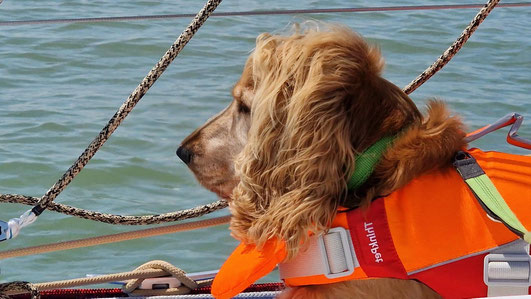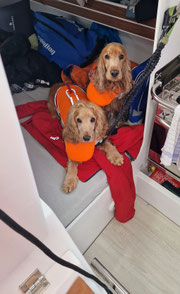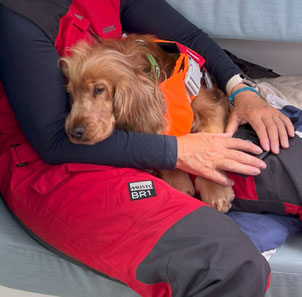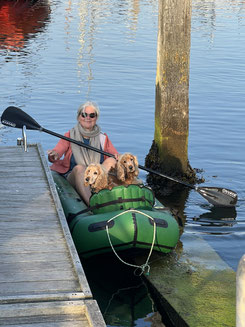Sailing with Your Dog – How to Make the Voyage a Great Experience for You and Your Four-Legged Friend

The sailing season is starting – and with it, the anticipation of freedom, wind in the sails, and dreamy anchor bays. For many water sports enthusiasts, having their dog as a loyal crew member is simply part of the experience. But what does it actually mean to set sail with a four-legged friend? What should you be aware of – and how can a sailing adventure be made safe, relaxed, and enjoyable for everyone on board?
We sail with our two Cocker Spaniels – and experience daily how differently dogs perceive life on board. One could spend hours enjoying the “harbour cinema”, happily watching the goings-on and feeling the wind on his face. The other is more of a loyal companion: for him, the boat is just a means to an end – as long as he’s with us, he’s content. And that’s exactly where the charm lies: with a little sensitivity, it’s possible to find a solution for (almost) every dog to make life on board a positive experience.
This article provides a comprehensive introduction to the topic of “sailing with your dog”. It’s based on our own experiences and stories from other sailors with dogs – offering you practical tips for a successful start to the sailing season with paws on deck.
Safety First - Live Jackets & More

Even if your dog is a strong swimmer, a dog life jacket with a carry handle is an essential part of your onboard safety gear.
It makes lifting your dog back onto the boat much easier – whether from a dinghy or a high quay – and offers added safety should your four-legged companion fall overboard.
Important to know: A dog life jacket is a buoyancy aid, not a full life-saving device.
It supports your dog while swimming but does not provide complete flotation protection in the event of exhaustion. Some models include a headrest to help keep the head above water – useful in an emergency if your dog cannot be recovered immediately.

On deck, your dog is safest in the cockpit.
There, you can keep an eye on them, and in rough seas, a safety lead attached to the harness helps prevent accidental slips. If your dog is allowed to move freely on deck, this should only happen
in calm conditions and with sufficient experience. In all other cases, the rule is: always secure your dog – safety comes before adventure.
Our dogs usually stay below deck in the aft berth while we’re sailing. Depending on the boat’s heel, they can lean comfortably against the sides and snuggle into the cushions – a protected retreat that offers them both security and rest while we sail above. Especially in choppy seas or on longer passages, this has proven to be the ideal spot.
Rough Water & Seasickness

Dogs can get seasick.
Just like humans, the severity of motion sickness can vary greatly from dog to dog. Keep a close eye on your dog, and watch for signs such as restlessness, panting or vomiting. Some dogs simply
sleep through the rocking motion – others may need extra reassurance.
Fresh water should always be available – special non-slip bowls are helpful when the boat is heeling.
There are medications that can help alleviate the symptoms of travel sickness. It's best to consult your vet for advice and suitable options.
Toilet Habits on Board – A Matter of Routine
Probably the most common question among sailors with dogs:
How – and where – does my dog go to the toilet? Most dogs find it difficult to relieve themselves on board – understandably so, as they quickly see the boat as their “home”, and that's not where
you do your business.
The simplest solution: plan a proper walk before setting sail. And once you're back in harbour, one person takes the dogs ashore while the other sorts out the boat. Afterwards, everyone gets to enjoy a relaxed harbour “drink” – in a glass for the crew, in a bowl for the dog. 🐾
For longer passages or extended cruising, a bit more planning is needed. Some long-distance sailors train their dogs to use artificial grass, designated spots on deck or specific routines – such as a particular time, a lead, or a cue word. This doesn’t work for every dog, but with patience and consistency, you can often make good progress.
Special Case: Anchoring

Planning to anchor during your trip?
Then you’ll definitely need a dinghy or packraft on board if you’re sailing with a dog – it’s essential for getting ashore safely and with minimal stress. It’s also extremely helpful when rafted
up with other boats.
To make shore trips go smoothly, get your dog used to travelling in the dinghy or packraft well in advance. Packrafts in particular can take some getting used to – for both dogs and humans. After a passage, things may need to move quickly: when nature calls, your dog won’t want to wait long.
Tip: Practise setting up and boarding calmly ahead of time, so that once anchored, every move is second nature – and your four-legged crew member can reach dry land quickly and comfortably.
Onboard Activities for Your Dog
Of course, the next trip ashore is often the highlight. But even on board, there are plenty of ways to keep your dog entertained. Favourites include swimming, paddleboarding, treat searches, brain games – or simply watching the world go by from the cockpit.
Make sure your dog doesn’t drink seawater – and rinse them thoroughly with fresh water after a swim. This helps keep their coat healthy and prevents sand and salt from ending up in the cabin.
Harbour Etiquette
Good behaviour is always appreciated – and that applies not just to the crew, but to the onboard dog as well. Your dog shouldn’t guard the pontoon or bark at other crews. Place their blanket in a quiet spot in the cockpit, away from the main walkway and commotion. That way, your dog will feel safe – and so will fellow sailors.
Special Situation: Rafting Up - What to Keep in Mind with Dogs
Especially during peak season, finding a berth directly at the pontoon is often a matter of luck. Quite often, several boats are moored side by side in what's known as rafting up. That means other crews may need to step over your deck – and vice versa.
➡️ Does your dog tolerate strangers on board? Great – things will stay relaxed.
➡️ Is your dog territorial or nervous? Then it’s essential to keep them on a lead and politely let other crews know how to behave – for example,
avoid eye contact or speaking directly to the dog.
And if you need to cross other boats with your dog: not every crew is happy to see four paws on deck. Always ask before crossing, carry your dog if needed – or use a dinghy or packraft to go ashore independently.
Important for all harbour strollers:
Please don’t pet or feed other people’s dogs – no matter how sweet they look.
Not every dog is comfortable with strangers, and treats given without asking can cause health issues.
Travelling Abroad:
Don’t forget the paperwork – and check your insurance cover!
If you’re planning to sail across national borders, it’s important to check the entry requirements for dogs in advance – especially for re-entry into the EU.
Within the EU, a pet passport with microchip and rabies vaccination is usually sufficient. However, some countries also require a rabies antibody titre test. Speak to your vet well ahead of time and allow plenty of lead time for preparations.
Some countries have additional rules – such as muzzle requirements in Italy or mandatory tapeworm treatment. It’s best to be well prepared!
It’s also worth reviewing your insurance cover:
✅ Does your dog liability insurance apply abroad?
✅ Will your pet health insurance cover treatment while travelling?
Gear & Grooming
A few items simply belong on board when sailing with a dog – they make everyday life easier and help ensure safety and well-being both on land and at sea.
Here’s a tried and tested basic kit:
🛥️ Safety & Mobility
-
Dog life jacket with carry handle
-
Safety lead for harness or collar
-
ToeGrips® for better grip on slippery decks (optional)
-
Packraft, dinghy or transport aid for shore trips (also useful when rafted up)
🍽️ Food & Supplies
-
Food (dry food recommended; long-life wet food also possible)
-
Treats for rewards and training
-
Water bowl & fresh drinking water
-
Collapsible bowl & water bottle for on the go
🧼 Care & Health
-
Waterproof tick and flea protection (vet recommended)
-
Vaseline or paw balm for tired or irritated paws
-
Cooling vest or sun protection vest
-
Towels for drying off
-
Fresh water for rinsing off after saltwater swims
-
Grooming supplies (brush, comb, nail clippers)
💊 Onboard First Aid Kit & Medication
-
Basic first aid kit with remedies for diarrhoea, nausea, insect bites, etc.
-
Bandages, tick remover, disinfectant
-
Regularly needed medication in sufficient quantity
Extra tip for boat dogs with unsteady footing: ToeGrips®

Deck surfaces on board are often slippery – and rough seas make things even more challenging. Constant movement makes it harder for your dog to keep their footing – and steep companionways or narrow steps don’t help either.
ToeGrips® are small, non-slip rubber rings that fit onto your dog’s nails. They provide extra grip, even on wet decks – and not just at sea, but also at home on tiles or wooden floors.
ToeGrips® – Key Benefits at a Glance:
✔ Non-slip rubber rings with stopper effect
✔ Better traction on smooth surfaces (e.g. deck, laminate, tiles)
✔ Patented GripZone to prevent slipping
✔ Long-lasting – can be worn for up to 3 months
✔ Supports mobility, balance, and gait
👉 More information: www.aktive-pfoten.de
Conclusion: Sailing with Your Dog – With Respect and Joy
Sailing with your dog can be a fantastic experience – as long as you're mindful of your dog’s needs. Good preparation, patience, clear routines and a touch of calm make all the difference. And when your dog dozes contentedly in the cockpit while you enjoy the sunset, you’ll know: bringing them on board was absolutely the right decision.
Wishing you a fantastic season with your boat dog!
Ahoy, Susanne Gnass

Kommentar schreiben